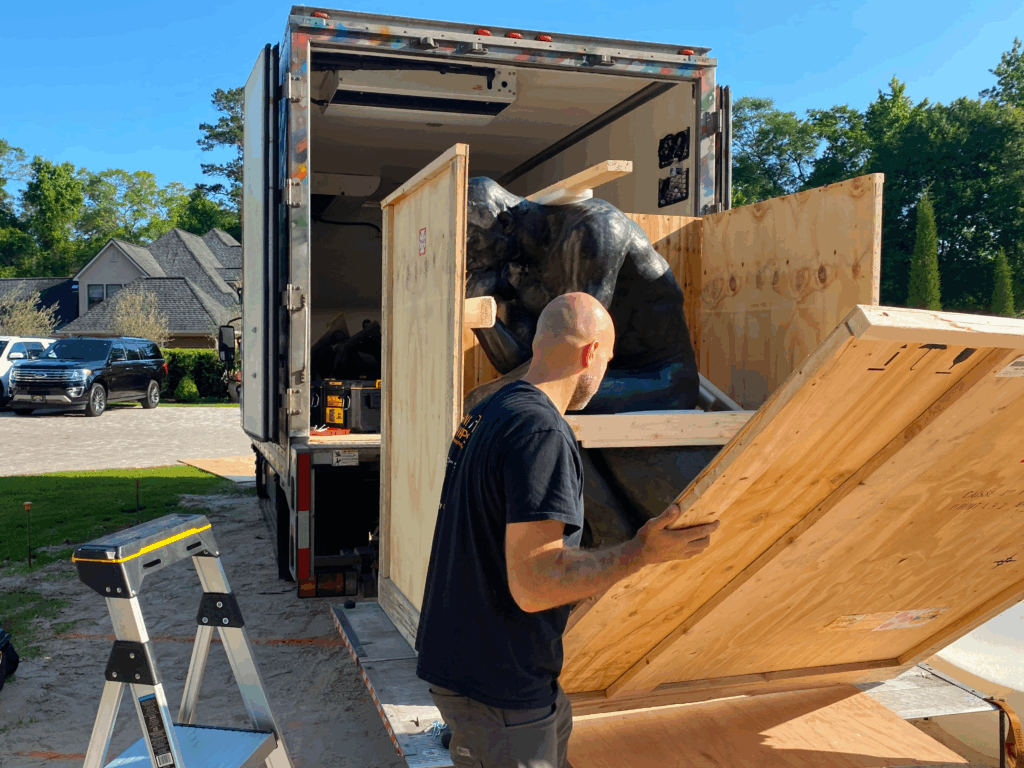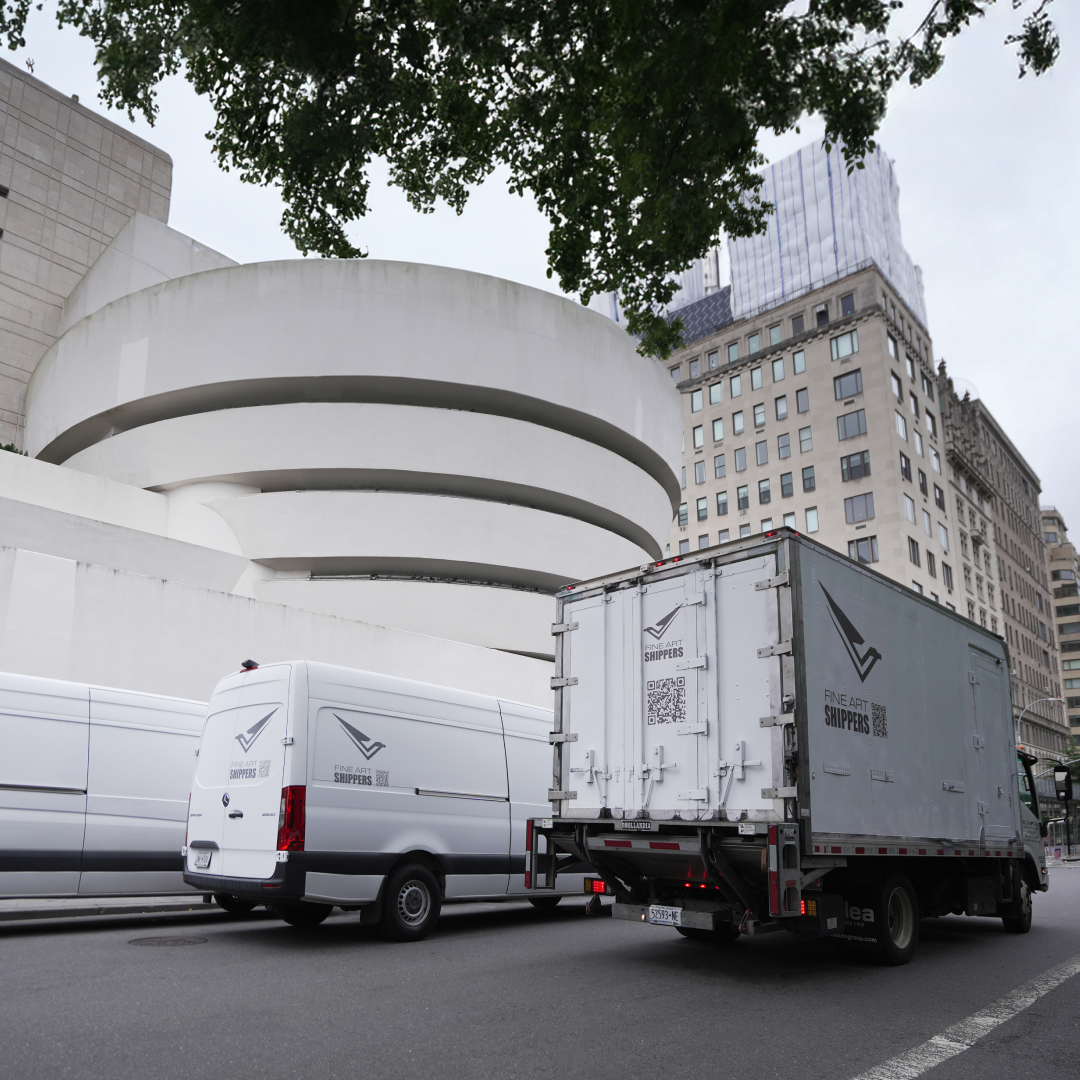In our interview, we talked about what matters most in art shipping and what gives clients true peace of mind.
Can you tell me a bit about your background and how you ended up in art logistics?
Elon: I majored in linguistics at university, but I’ve always had a deep passion for art. So when I started this job, it felt like the perfect match. I’ve been in art logistics for a while now, and I love that it allows me to stay close to the art world while doing something dynamic and practical.
What kind of work do you typically handle in your role?
It really varies, but broadly speaking, I coordinate the shipping process with our clients, everything from pick-ups and deliveries to working with clients—museums, collectors, and galleries. Some of it is domestic, but we also handle international shipments. Over the years, I’ve worked with all kinds of art.
What does a typical day look like for you as a sales manager?
I’m usually the first person clients talk to when they reach out. My job is to understand what they need, so I gather details like dimensions, deadlines, and any special handling instructions—and then put together a quote for them. Then, I stay in touch throughout the process. If they have questions or special requests, I work with our internal team to make sure everything goes smoothly.
So you're the main contact throughout the entire process?
Exactly. I stay involved from the first conversation to the final delivery. Clients want to know that someone’s keeping an eye on every step, and that’s my role. I make sure they feel comfortable the whole way through.

Sounds like relationship-building is a big part of what you do.
It definitely is. A lot of our work is based on trust. People are handing over valuable artwork, so they need to feel it's being well cared for. Being responsive, clear, and attentive makes all the difference.
What soft skills are essential in your role and art logistics more broadly?
Art logistics is still logistics, but it’s a highly specialized niche. What sets it apart is what we’re transporting, which is fragile, high-value artwork. This value can be both monetary and sentimental. Either way, clients are trusting us with pieces that mean a great deal to them.
So one of the most important soft skills is confidence—being able to reassure clients that their artwork is in good hands. That comes not only from knowing our procedures but also from the professionalism of the team I work with. In short, communication, empathy, and trust-building are key.
Can you walk us through the logistics team structure at Fine Shippers? Who's involved in making a shipment happen?
We have the sales team—people like me—who interact directly with clients. Then there are the dispatchers, who handle scheduling and coordinate with drivers. We also have professional art handlers. These are people trained specifically to manage delicate, high-value works. All our handlers have at least five years of experience, which is a baseline requirement for us. Another essential part of the process is our insurance partners, as you can’t move art without proper insurance coverage.
On a personal level, what do you love most about your job?
I just love being around art. It feels special to be part of that world. I also really enjoy the human side—talking with clients. Our customers range from major institutions to everyday people with personal collections. Every artwork has a story, and many clients love to share those stories. Listening to them is one of the best parts of my work.
Can you tell us about a particularly memorable delivery?
One of the biggest projects I’ve worked on involved transporting a Banksy mural. We’re actually the only company that’s moved Banksy murals twice. In the case I handled, we had to cut the mural out of a wall and ship it on a flatbed truck. It was incredibly complex: lots of people involved, many logistical layers. But in the end, very rewarding when it all came together.
That said, some of my favorite jobs are smaller, more personal. I remember a lady who contacted us about a chandelier her late father had gifted her mother. It wasn’t valuable in terms of money, but it meant a lot to her. She wanted to ship it to her sister. Our job was to deinstall, pack, and reinstall it. She shared stories with me throughout the process, and it was just one of those moments where you’re reminded that what we move isn’t just objects.
Is there something people often misunderstand about art logistics?
Most people don’t realize how different art logistics is from regular shipping. We’re not just moving objects from A to B. It involves careful handling, climate control, insurance, storage, and sometimes installation. People often think any mover can do it, but transporting artwork is a whole different field. It's not just about the object—it’s about protecting it.
For those unfamiliar with art logistics, what advice would you offer?
My main advice: don’t treat art like furniture. Common carriers or general movers aren’t equipped to handle it. Fine Shippers specializes in this work: we only ship art, and that matters.
We have climate-controlled trucks that are custom-designed to ship art and antiques only. They’re not loaded with random items like you’ll find with general carriers, meaning your piece isn’t bouncing around next to a stack of furniture or office equipment.
Our handlers are trained professionals with years of experience, and that’s a big deal. With a common carrier, you’re relying on general freight staff who may have never handled a piece of art before. And insurance is critical. Most general carriers only cover loss, not damage. We offer insurance that covers both.
That said, our services may cost more than standard movers, but you're paying for safe delivery and peace of mind. Believe me, it's worth it.
Interview by Inna Logunova
